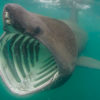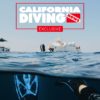Lobster season opens Saturday, October 3, and many California divers are eagerly awaiting it. This article provides information on the life cycle of these savory crustaceans as well as tips and techniques that will help you catch them.
First, let’s take a closer look at Panulirus interruptus, aka the California spiny lobster. The most obvious difference between it and the East Coast’s American lobster is that the American lobster has big claws and the spiny lobster has none.
While some sea creatures are involved parents others have little or no contact with their offspring. The spiny lobster is one of the latter. Lobsters reach sexual maturity at five to six years of age. Mating takes place in 50 to 100 feet of water.
To ensure his species’ survival, the male has only one task, carried out between November and May each year: mating with as many female lobsters as possible, depositing a spermatophore –also called a “plaster” — on each partner’s sternum. You may have seen plasters on the undersides of bugs but not known what they were. White and sticky when fresh, they turn black and harden in a few days.
Between May and June, the female moves to waters less than 30 feet deep. When she is ready to spawn, she uses pincers on her fifth pair of walking legs (males lack these pincers) to break open the plaster so the sperm inside can fertilize the 80,000 to 800,000 coral colored eggs she will release from ducts at the base of her third pair of walking legs. The eggs adhere to her fan-shaped, multi-layered swimmerets, which are much larger and more complex than the male’s. The bigger the female, the more eggs she can carry and the more she produces. There has to be such a large number of eggs because the young have a long and perilous path to adulthood. (Note: To prevent “berried” — i.e., egg-bearing — females and newly molted lobsters from being taken, lobster season is closed from the middle of March to the end of September.)
The female’s parental duties last only until her eggs hatch nine to ten weeks after she spawns. The tiny, transparent pelagic larvae (.06 inches long) have large, pigmented eyes, flattened bodies and long legs. They bear little resemblance to their parents. In the next seven to nine months, they will drift with the currents, eating plankton and, if they don’t get eaten themselves, molting 12 times.
According to California Fish and Wildlife literature, “lobster larvae have been found as far as 350 miles offshore and as deep as 400 feet below the ocean surface.” Only three percent of the hatchlings are estimated to reach Stage 11, at which point they look somewhat like their parents and are about 1.14 inches long. From May through September these larvae swim to shallow water and settle to the bottom. After their next molt, 9 to 11 days later, they look like miniature adults.
Juveniles seek shelter in areas with surf grass, southern sea palms, bushy brown algae and kelp, all of which are abundant at San Clemente. The island is known for its large population of shorts and is often called “the lobster nursery.” Juveniles subsist for the most part on amphipods, isopods and vegetal material.
Adult P. interruptus has a varied diet that includes fish, sea urchins, clams, mussels, scallops, sea stars, snails, worms, kelp, algae and even other lobsters.
Several years ago I watched an extraordinary presentation by a student at USC’s Wrigley Marine Science Center on Catalina, who had set up time-lapse cameras on Bird Rock and captured images of lobsters crawing out of the ocean at night to feast on mussels that were left high and dry at low tide.
Lobster predators include several fishes, along with octopuses, moray eels and horn and leopard sharks.
Lobsters must shed their outer shells (exoskeletons) to grow. According to Seashore Animals of the Pacific Coast, “the body shrinks away from the exoskeleton before it is withdrawn, and the animal escapes through an opening formed on the upper side between the carapace and the first abdominal segment.” About 40 molts occur before a lobster reaches legal size. That means the carapace is 3.25 inches long when measured on the mid-line of the back from the rear edge of the eye socket to the rear edge of the body shell.
At that point the lobster will be 7 to 11 years old and weigh about a pound. Male lobsters grow faster, live longer and grow larger than females. The biggest one on record was three feet long (excluding antennas) and weighed 26 pounds (wouldn’t we all love to see one of those!). It is estimated that male spiny lobsters can live 30 years or more, females up to 20 years.
During the winter, most lobsters are found offshore at depths of 50 feet or more. In late March, April and May, they move closer to shore in warmer waters less than 30 feet deep. They move after dark in small groups.
Spiny lobsters have two methods of locomotion, walking and jetting rapidly through the water, propelled by flapping their powerful tails. Though their landing places are impossible to predict, jet propulsion is a very effective way to escape predators — at least for awhile.
Panulirus interruptus is only found off the West Coast from Monterey Bay, CA, to Magdalena Bay, Mexico.
Tips for Successful Lobster Hunting
Right off the bat I’ve got to tell you, it isn’t easy. Those with the best chance of catching spiny lobsters are excellent divers with great reflexes. They know where to grab a lobster so it won’t escape and are well versed in the art of bagging a bug. These people have buddies who know how and when to help and have agreed on the division of the booty, should there be any.
Successful divers are also familiar with lobster taking laws (and Marine Protected Areas where lobster may not be taken), know where to get a California Fish and Wildlife Sport Fishing License with an Ocean Enhancement Validation and a Lobster Report Card, and own and know how to use a spiny lobster measuring gauge.
Let’s start at the beginning.
Seeking: The first thing you need to know is where to look for lobsters. Rocky crevices, the deeper the better, are lobsters’ favorite places. Look for their antennas poking out of crevices or from under rocks, sampling the water for clues as to what is happening in the ocean around them. While some think lobsters couldn’t possibly know when lobster season is, I have only seen them lounging around outside their dens when it is closed.
Securing: Many novices end up with legs and antennas in their game bags. Don’t grab these lobster parts because they break off easily (and will be replaced when the lobster molts). Instead, aim for the thick “horns” at the base of the antennas. Lobster tails, which have sharp spines, are also bad places to grab. You will not get a good purchase and the bug will wiggle out of your grasp. If you find a lobster out in the open or it comes out of its den, try to pin it to the bottom with one hand while grabbing a horn with the other. “He who hesitates is lost” is applicable here. Surprise is a great advantage. Grab first, think later. Remember, lobsters are always sampling the water with their antennas, looking for things to eat and things that might eat them. They will take advantage of any hesitation on your part to back deeper into their dens or jet out of them. It helps to have a conviction that you are going to prevail. This is one of the things common to successful lobster catchers.
There is a caveat here. Lobsters share their dens with a variety of other creatures, including other lobsters and moray eels. Do make sure you don’t stick your hand into a crevice and into the mouth of moray, as my younger brother once did. He wasn’t seriously injured but he could have been.
Bagging and Measuring: If you were paying attention to the first part of this article you will have learned that bugs have an awesome ability to “fly” backward through the water by flapping their tails. That is why you should always bag a bug tail first. That way, if it squirms out of your grasp it will go into the bag, not out of it. And while this sounds easy, it isn’t. Make sure you have a firm grasp on the horns before you do this and close the bag on your arm while you are still holding the bug. It would help if we had three arms but since we don’t a buddy can be very useful here.
Divers may only use their hands to take bugs and must measure them before coming ashore or climbing aboard a boat. If you measure them on the surface, any “shorts” must be released immediately. You may not clean bugs until you have reached home.
Storing Live: It is important to keep lobster alive until you get them home because the meat will spoil if exposed to heat. Some boats have live game wells you can use. Otherwise (and when it comes time to disembark), a cooler and some ice packs are helpful in keeping your bugs damp and cool. I’ve been told they can live out of water for about 24 hours if they are properly cared for.
Too tired to clean your bugs when you get home? Put them in your refrigerator. When my children were young, they always checked the vegetable crisper the morning after a lobster trip.
Equipping: Since lobsters can only be taken by hand, the only extra gear you’ll need to hunt for them is a lobster measuring gauge and a game bag. I carried a light around on my daytime dives for years before it occurred to me that if a bug was so far back in a crevice that I needed a light to see it, I wouldn’t be able to reach it. You’ll also need a thick pair of gloves, preferably not made of neoprene, which lobster spines can easily penetrate.
Night Diving: Lobster are nocturnal and they hunt at night. Although I have always heard it is easier to catch them then, I never found that true — not for me anyway because having to use a light was an impediment. Lobsters were aware of my presence long before I was ready to grab them. Also, if you dive places popular during the day, at night lobsters already know exactly what bubble blowing visitors are after and won’t stick around. In my opinion, your best chance of catching bugs at night is to be one of the first divers in the water on opening night, when the bugs aren’t aware they have become legal. Once they do, they are much harder to grab. Also, you have a better chance of being successful if you are experienced at both night diving and lobster diving. Become proficient at one first, then the other.
Resources
California Fish and Wildlife has free PDF downloads of Marine Protected Area maps as well as a brochure that provides all the rules and regulations re: lobster diving and any other sea creature you might be interested in taking. The latter, entitled California Ocean Sport Fishing Regulations 2015-2016, is available on the same website where you can buy a Sport Fishing License with an Ocean Enhancement Validation and a spiny Lobster Report Card, all of which you’ll need. Go to wildlife.ca.gov/Licensing/fishing.










